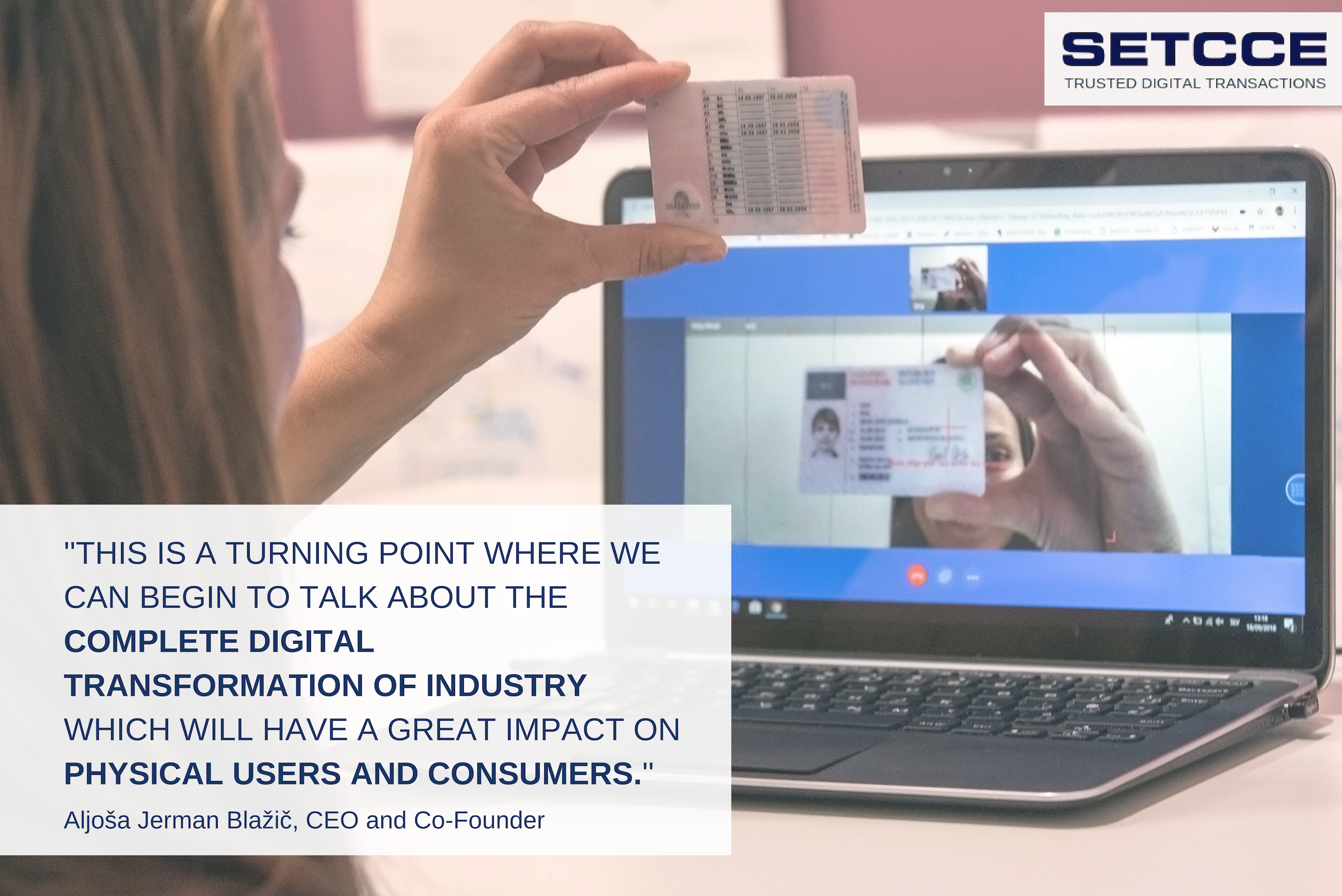The days when retired people would have to queue up at the bank at the end of the month and have their entitlement checked in the bank register are long gone, and the socialising and random conversations that went with that have almost completely disappeared. The digitalization of identification services has passed from telecommunications companies and financial institutions to become an integral part of all our lives. Video identification is just one more step in this direction. The SETCCE company has also been busy developing new technological solutions. Nataša Zanuttini from a major Slovenian Radio Station - Val 202, spoke to CEO Aljoša Jerman Blažič about the digital transformations taking place in our everyday lives. Read the English transcript below.

What is the rate of adoption among today’s companies when it comes to video identification?
The use of video identification and digital transaction management services, which encompass digitalized processes, electronic signatures, electronic storage, electronic identities and so on, has, up to now, been a feature primarily of telecommunications companies and financial institutions such as banks and insurance companies. Today, however, we are seeing these technologies beginning to spread to other industries. We can observe two moments here. The first is that these technologies are beginning to be used by manufacturing, retail and similar industries. What is most encouraging to me personally is the trend that has begun to develop very intensively in Slovenia, where these technologies are already being sought out by small and medium-sized enterprises. This means that we are currently at a turning point, one where we can begin to talk about the complete digital transformation of the industry – which of course then has an impact on physical users and therefore on consumers. And this was the key moment, one that had to happen last year and this, and one that will truly take the digital transformation trend forward and have a concrete local and global effect.
What is the most important factor behind this? Is it the savings made, the security or globalization?
We have to take all three into account. Saving money is certainly something all companies are interested in – and there are definitely savings to be made. The second is globalisation. Markets are no longer local, but global. If we want to be successful, we have to invest more time in thinking about how to place our services on other markets. Let us say you’re a company like ours that would like to position itself on other, foreign markets. If I look back to 20 years ago, such a process would have executed with huge investment costs as we would have needed a physical presence on those markets. Now, through digital channels, we can set up a partnership network very quickly, reach an agreement, share information and establish a suitable environment using digital tools, sign contracts remotely, again using digital tools, and so on. And that is what is important. I am personally convinced that any company that does not latch onto this digital trend, which has now begun to develop even more rapidly, will find their market narrowing in the very near future. And of course, such companies will be putting their business at risk with their reluctance to use digital tools.
Video identification technologies have been developing for a long time already. Some banks are based on a business model that acquires new customers exclusively by means of video identification. Investments must be made in the digital transformation of business every day by developing new technologies and approaches.
As you yourself have noticed, we have already ‘conquered’ video identification in terms of technology and process. Some banks abroad are already using it on a daily basis. But this has developed even further. N26 bank for instance, is one of the best-known banks associated with this business model. This bank does not have a single branch. It is based in Germany and acquires its customers exclusively using video identification processes. Our innovation lies mainly in the fact that we are trying to conduct the entire cycle, the entire process, from start to finish – that is, from identifying the user to creating the electronic identity they subsequently use to confirm digital transactions so that they can sign contracts, approve a document or enter into business cooperation with a service provider or business partner. Support for this process features technologies and procedures that are innovative in themselves and incorporated in an innovative way.
How secure is it?
Yes, it is particularly important for these procedures to be supported by appropriate regulations, so the right legal framework has to be established at the outset. We have implemented this in Slovenia in a similar way to other European countries via the Anti Money Laundry regulation act. This act does deal with certain other issues but, as has been shown in other European countries as well, this is a law in which other procedures can be included for identifying an individual who wishes to perform certain financial transactions remotely via video link. For us, this is a framework that defines what is possible. We should point out from the outset here that video identification is currently subject to its own legal restrictions – for example, in most European countries, the transactions made via video identification are limited to 15,000 euros. On the other hand, we have developed technological tools that enable us to ensure that such transactions are as secure as possible. Slovenia stands out somewhat in this area in that we have, as it were, prohibited the use of biometric data.
Other countries make good use of biometry precisely because every transaction can be linked uniquely to the person attempting to confirm the transaction. So I do believe that security is at a very high level. Even in certain contexts, if we talk specifically about video identification, security is even better than physical presence because it is a procedure that always leaves a trace. We perform every video identification procedure in such a way that an audit trail is created – that is, we record data as audio recordings, which are archived, take a photograph of the identified person, which is also archived, and prepare or compile personal data. We provide appropriate protection for all this data, which is why I personally believe that security is better catered for in electronic identification than in physical verification, as the latter contains no audit trail that features this much data.
Larger companies have been the first to undergo a digital transformation. The opportunity to optimise business operations is surely the main reason behind this.
Optimisation is currently one side of the story. The other side is that digital services have made it extremely easy for the market to globalise. Again, if we go back to the N26 bank, a bank without branches, it has around a million customers (or at least that is what it is claiming at the moment), and they come from all over the world. There was no need to open branches in Slovenia, although quite a few users of their services do come from this country. That is one of the other reasons or motivations compelling companies to seek out digital technologies: they will simply be left out in the cold in their local market or, worse still, their business will contract to such a degree that they will become unprofitable and gradually fail, or will be forced out of the market by others.
Is video identification perhaps even a limiting factor for individuals?
I myself do not see it as a limiting factor, nor do I see it as something that will entirely replace physical presence. Branches will remain, so there will always be personal contact of sorts. What video identification does is expand our access to services in terms of time and location. Not only that, let us look at what has happened with online stores, which emerged as one of the internet’s first general business models sometime in the 1990s. One of the most valuable companies in the world today, amazon.com, is, in reality, a highly dispersed online store. Why? Because buyers actually want to make purchases from home or wherever they are. With video identification, which enables access to services mainly through digital channels, is not a limitation but, rather, an incentive. There is a very apt term in English: ‘enabler’. So we can place digital services and deliver them via digital channels to users wherever they are. Therefore, physical branches and online services will coexist. In any case, I do not fear the collapse of physical branches or shops. The question, however, concerns the direction in which everything will develop going forward. We have mainly been talking about one group, one little facet of video links as video identification procedure, but we know, in America, say, and in some European countries, mainly in the banking sector, that they are already pushing digital channels as well as video services per se very strongly. So instead of visiting a branch, you can talk to an agent live via video link, which is definitely a welcome development. We do not yet have this in Slovenia – or rather, one of the banks has already plucked up the courage to introduce it, but it is not as widespread as it is in some other countries.
Implementation of these new technological and developmental processes, costs for companies, for public administration, for smaller companies etc.
Video identification brings immediate savings. Two things have to be understood here. New business models have arisen with the arrival of the new digital technologies we are placing on the market. It is very important to understand this, as it used to be the case that considerable startup investments were required for the introduction of such technologies. Things have changed to an exceptional degree today. The video identification we are offering to the market, and everything associated with the performance of digital transactions, is provided as cloud services. Therefore, startup costs have fallen in relative terms. In fact, they are very low and the business models enable us to use these services or pay for them after using them. This means that we can arrive relatively quickly at a comparison between what the costs were before, on paper or at the branch, and what the costs are today using digital channels, digital contracts and electronic signatures, for example. What are the investment returns like? We are also seeing returns within a few months and, when the move is made to cloud-based services, the return on costs is practically immediate.
Of course, for the new generations coming through, digital transformation has an entirely different meaning.
I think this is very important to understand because there is a generational leap when it comes to millennials or Generation X. Unlike us, they have grown up with smartphones or with devices that are constantly connected to the internet. This means that they expect services to be accessible from their pocket anywhere and at any time. We have to understand these changes. I should point out here that some companies that have achieved unbelievable market capitalisation today, such as Airbnb and Uber, have grown up precisely on an understanding and use of technology. Airbnb is a more valuable company than the Hilton hotel chain by not owning a single item of real estate. So the coming generations have begun to adopt digital technologies very rapidly. What’s more, they see digital technology as a precondition for the consumption of a certain service, and so this opens up space for new business models and new groups of users. Digital channels are indeed inescapable.
Because the video identification required if one is to be involved in this system is in some way taken for granted, and is self-evidently secure and straightforward, right?
Of course. I register once on Uber or Airbnb, and I do not expect to go through another identification procedure the next time I use the app. So these background technologies are very important because they provide the basis for new business models and new economies.
SETCCE’s CEO Aljoša Jerman Blažič was talking to Nataša Zanuttini.
Link to broadcast in the Slovenian language.








